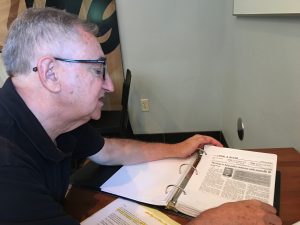During a period in which five people were killed by law enforcement in Butte County, overall attendance at the county’s annual week-long training program in crisis intervention has been in steep decline.

Sal Ventura
However, the Chico Police Department – roundly criticized for past absences at crisis intervention trainings – has stepped up participation since the killing of Desmond Phillips, a young black man in mental crisis.
Chico PD sent six officers Oct. 8-12 to the ninth annual Butte County Crisis Intervention Team (CIT) training, which was sponsored by Butte College and is patterned after the so-called Memphis Model approach to the treatment by police of individuals in mental crisis.
Making de-escalation normal police practice and improving training in crisis intervention top the agenda of a group calling itself Concerned Citizens for Justice (CC4J), which formed in the aftermath of the 2017 fatal Chico police shootings of Phillips and Tyler Rushing. CC4J has been researching ways of expanding citizen oversight of police. Chico City Council candidates attending a forum sponsored by CC4J agreed in their support for more CIT training.

Overall attendance at this year’s 40-hour program was down for a second straight year – with the Butte County Sheriff’s Department in particular sending fewer personnel than in recent years past. The 16 total attendees at 2018 Butte CIT is a drop from the 21 attending in 2017 and the 29 enrolled in 2016. The two-year decline in attendance is about 45 percent.
One month before the training, when Butte College first provided to ChicoSol information about this year’s CIT, only four officers (three from the Paradise Police Department and one from the Sheriff’s Department) had registered. At that time, the college was officially referring to the training as “tentatively scheduled.”
A couple of weeks later, with the roster then up to nine, officials decided to move forward with the CIT academy, said Don Beasley, interim director of the college’s Public Safety Education and Training Center. “I hate to turn down the nine; that’s kind of the way we’re looking at,” Beasley said at the time.
The 16 who attended last week included seven officers from the Sheriff’s Department and three from Paradise PD – the only two law agencies that have consistently supported CIT since its inception in Butte in 2010. The Oroville and Gridley-Biggs police departments generally have not participated.
Chico PD sent a total of only two sworn officers to Butte CIT during the four-year period from 2013 through 2016. But in addition to having the six officers at 2018 CIT, Chico PD was represented by four personnel in 2017. The department now has about 20 officers who have completed 40-hour CIT training, said Police Chief Mike O’Brien. In addition, a total of nearly 200 “officers, dispatchers and civilian personnel” have attended various eight-hour trainings the department has sent staff to or hosted for the community during the past several years, according to O’Brien.
An ‘opportunity lost’
As with the Desmond Phillips shooting 30 years later, the Memphis Model grew out of the killing by police of a young black man in mental crisis.
Sal Ventura of Chico, who’s in his second stint as a member of the Butte County Behavioral Health Department board, was a member of a task force that established Memphis Model-type training in Butte County. The group worked for a couple of years to help launch the first 40-hour training program in 2010.
Through the years, Ventura said he “became kind of disillusioned, always with that sense of sadness,” with how the Memphis Model had evolved in Butte County. Today, he describes the decade-long effort and “an opportunity lost.”
“We definitely don’t have a Memphis Model here,” Ventura said. “No blaming anyone, no criticizing, just the way it is.”
Ventura said any Memphis Model should focus on training and providing prestige to officers who have an affinity for CIT, and having those personnel available every shift.
Ventura said the CIT program in Butte, beyond the annual academy, has provided “no follow-up, no recognition, no sense of purpose.”
As Ventura sees it, an essential element missing from CIT in Butte is broader community involvement. One way to improve is to “get out of the classroom where people with mental illness are,” he said. “So police officers can see these people when they are not in crisis. Also, the consumers (of mental health services) will know these guys are good people.”
Leader quits CIT
For its first seven years, Butte CIT was led by Butte County sheriff’s Capt. Andy Duch, in partnership with Don Taylor, assistant county behavioral health director.
In the aftermath of the Phillips killing by Chico police, Duch abruptly quit as CIT leader, saying it was in protest over the way Chief O’Brien and Butte County District Attorney Mike Ramsey were representing Chico PD’s commitment to training in the news media. In a ChicoSol exclusive, Duch called their claims “overstated and deceptive … propaganda.”
Linda Dye, a retired Chico PD lieutenant, has been Butte CIT’s lead teacher since Duch departed.
As first reported by ChicoSol, Chico PD in April bolstered its ability to respond to people in mental health crisis by partnering with the Butte County Behavioral Health Department. Two mental health counselors work day shifts seven days a week as a Mobile Crisis Team (MCT) to respond to situations as requested by officers.
In a recent progress report to the City Council on the pilot project, O’Brien said the number of cop-counselor co-responses totaled 163 from April 1 through the middle of August. O’Brien’s report says the utilization of the counselors by police has steadily increased, with a bump to 32 co-responses during the period from July 29 to August 18.
O’Brien wrote that the joint venture has “proved tremendously successful” to the city, Behavioral Health, Enloe Medical Center, “and especially those community members served by this team.”
“The partnership has developed to such a degree that officers routinely request MCT response,” O’Brien wrote. “It is clear the partnership has saved the city of Chico hundreds of hours of staff time.”

Chico Police Chief Mike O’Brien
A criticism of the pilot project is that the MCT counselors work only day shifts. Author Pete Earley, who has written about mental illness, asked a Chico audience last spring: “Who has a mental breakdown from 8 to 6?”
A second MCT, working with the sheriff’s office, is planned for south Butte County in 2019.
Sheriff defends drop
County Sheriff Kory Honea took umbrage at ChicoSol’s questions about the drop in sheriff’s personnel attending CIT, saying it was a natural result of having numerous officers at the training every year. The sheriff said he sends as many employees as possible while maintaining adequate staffing levels. Fourteen sheriff’s personnel attended CIT in 2015, 14 also were enrolled in 2016, while six came in 2017.
“We have an extraordinarily strong commitment to training our staff in CIT, and we will continue to do so,” Honea said.
Prior to last year’s CIT, Honea told ChicoSol that a total of 43 sheriff’s employees -– deputies, jailers and dispatchers — had gone through the 40-hour CIT training.

Butte County Sheriff Kory Honea
Five people were shot dead by law officers in Butte County during the 13-month period from March 2017 through April 2018. The officers involved in the last three fatal shootings in Butte County were all sheriff’s deputies, including those killing Myra Micalizio, 56, of Palermo.
Micalizio was in mental crisis April 26 when shot multiple times by deputies Charles Lair and Mary Barker. Micalizio’s family has filed a federal civil rights complaint against the county.
According to a sheriff’s office news release, the unarmed Micalizio died in a hail of bullets just 15 to 20 seconds after the two deputies arrived and confronted her. The shooting, which happened six months ago, is still under investigation by DA Ramsey’s Officer Involved Shooting/Critical Incident Protocol Team. In contrast, Ramsey issued a report exonerating the officers who killed Desmond Phillips in less than a month.
The Micalizio family’s complaint claims the officers failed to use basic protocol for handling people in mental crisis, including “maintaining physical distance … engaging in non-threatening communications … deliberately pulling back, allowing the person more time to respond … (and) consulting … persons trained in crisis intervention.”
Deputies Lair and Barker also did not turn on their body cameras prior to shooting Micalizio.
Dave Waddell is news director at ChicoSol.

Excellent article. The “Memphis Model” has been utilized by many police departments and sheriff departments across the country in large and small communities with the desire to effect a peaceful outcome from interactions between the mentally ill and police. Also, citizens review boards of officer involved fatal shootings are common throughout the country and have been proven effective in reducing the incidence of fatal shootings of civilians by officers. Their are many experts and models from which a community can choose to fit their unique needs when crafting a citizens review panel.
Does Chico/Butte County have a Citizens review panel for these issues?
Thank you for re-running this article. I missed it the first time. This is important information that is a call to action to those in our community concerned about the excessive use of force we have seen.